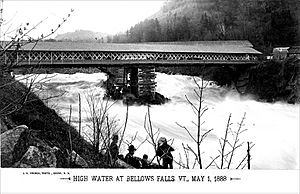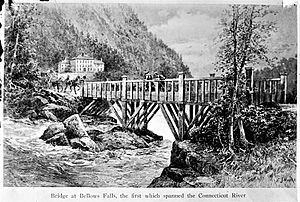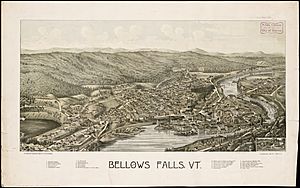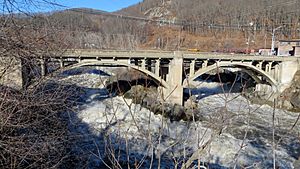Great Falls (Connecticut River) facts for kids

Great Falls is a powerful waterfall on the Connecticut River. It sits between Walpole, New Hampshire, and Bellows Falls, Vermont. People also used to call it "Bellows Falls." Its original Abenaki name is Kitchee Pontegu, which means "great falls." In 2016, "Great Falls" became its official name.
The waterfall drops about 52 feet (16 meters). The nearby village of Bellows Falls was built here to use the river's water power. This power helped run many businesses. Before this, the main town was on higher ground, away from the river's power.
Contents
The Bellows Falls Canal
The Bellows Falls Canal is one of the first canals ever built in the United States. It was dug between 1791 and 1802 by a British company. The canal was made so boats could travel past Great Falls without going over the waterfall.
Later, from 1926 to 1928, the canal was made much wider and deeper. This was to bring more water to a new hydroelectric power plant. The amount of water flowing through the canal increased a lot, from 1 million gallons per minute to 4.2 million gallons per minute!
Because so much water went into the canal, less water flowed over Great Falls. You can see the falls with less water, except during late winter and spring when the river is very high. To make space for all the extra water from the power plant, workers blasted away parts of the riverbed in 1928. The rocks they removed were used to extend the shoreline on the Vermont side of the river. An accident happened during this work.
Bridges Over the Falls
The Great Falls gorge is the narrowest spot along the entire Connecticut River. This made it a good place to build the very first bridge across the river.
The First Bridge
Colonel Enoch Hale built the first bridge here in 1785. This bridge was later replaced by the Tucker Toll Bridge in 1840. The new bridge was built 15 feet (4.6 meters) higher than the old one. This was because the first bridge almost washed away during floods. You can see the Tucker Toll Bridge in the second and third pictures on this page. In 1904, the towns nearby bought the bridge, and people no longer had to pay a toll to cross it.
Later Bridges
In 1905, a new steel Arch Bridge was built upriver from the dam. This likely meant fewer people used the Tucker Bridge. The Tucker Bridge was then replaced by the Vilas Bridge in 1930. You can see the Vilas Bridge in the fourth picture. Sadly, the Vilas Bridge was closed in 2009 because it was unsafe. As of 2020, there are no clear plans to fix or replace it.
Railroad Bridges
There was also a covered railroad bridge just upriver from the old toll bridge. You can see it in the second and third pictures. This bridge was built in 1849 for the Cheshire Railroad. Later, in 1899, an uncovered stone arch bridge replaced the covered one. Parts of this stone bridge are still standing and can be seen behind the Vilas Bridge in the fourth picture.
Log Drives on the River
From 1869 to 1915, many logs were floated down the Connecticut River in what were called "log drives." Smaller log drives continued until 1919. Some logs were taken out of the river above the dam and used in local paper mills. But many logs were sent right over the dam and down the falls! Men would guide the logs through the gorge. Most of these logs were sent to sawmills near Holyoke, Massachusetts.
Logs were often stored in special coves along the river, like Albees Cove near Bellows Falls. Stone pillars were built around these coves. Before a log drive, long logs were chained between these pillars to hold the other logs. The tops of these pillars were later removed, but you can still see the shorter stone pillars when the river level is low.
Amazing Survivals at the Falls
Two people are known to have gone over Great Falls and survived!
The first was an "Indian woman" before 1781. She was trying to cross the river above the falls in a canoe but was pulled into the powerful current. She survived by lying down in her canoe as it went over the falls.
The second person was Captain Paul Boyton. On October 30, 1879, he went through the falls wearing a special rubber floating suit. About 2,000 people watched him! Boyton later said that the water pushed him down with a "terrible weight" to the bottom of the river. For a few moments, he thought he might not survive.
Ancient Rock Carvings
There are two groups of petroglyphs, which are ancient rock carvings, on the Vermont side of the falls. This area is called the Bellows Falls Petroglyph Site. They are located just downstream from the Vilas Bridge.
If the river is not too high and the plants on the riverbank are not too thick, you might be able to see these carvings. You can often view them with binoculars from near the eastern end of Bridge Street in Bellows Falls, without having to climb down the steep bank.




